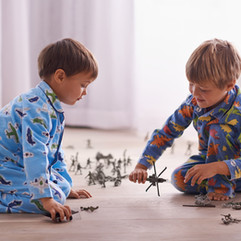10 TIPS FOR INTRODUCING CHILDREN TO NEW DOGS
- ...

- Nov 12, 2019
- 3 min read
By Amber Kingsley

With the holidays just around the corner, these 10 tips may well prove helpful in having a safe and fun holiday season!
"We have all heard the saying that “dog is man’s best friend”. Generally, this mantra rings true. Most of us can recall heartwarming stories or remember times spent with our favorite pets. Time and time again, dogs have become valuable members of our families, helping teach our children love, respect, responsibility, and gentleness. This bond between our families and four legged pals last lifetimes and earns our pups a special place in our hearts.
This time honored love between pooches and people can find many of our families looking to bring a furbaby into our homes or to visit with the neighbor dog. This process can be wonderful and exciting, but we should proceed with caution when introducing our children to new dogs. Unfortunately, for all the good, there are times when dogs bite or react in an unfriendly manner. Everyday around 1,000 people seek emergency treatment for dog bite injuries. As parents, we need to do everything we can to prevent our children and beloved pets from ending up another statistic.
Thankfully, by teaching our sons and daughters the appropriate way to approach new dogs, handle pets, and remain calm around animals we can greatly reduce the chance something bad will happen. Listed below is a compilation of ideas to help introduce our children and dogs safely:
Teach children how to gently touch and pet animals. Children love animals, but they often don’t realize they are squeezing or pulling a dog’s coat. Far too often, children unintentionally hurt dogs which can result in bites or aggressive behaviors. Avoid these problems by showing the proper way to pet a dog.
Have a child calmly approach the dog from the side and stop with enough room to allow the dog to willingly come to the child. This allows the animal to watch the child without feeling overwhelmed and greet the kid on his or her own terms.
Experts recommend using a leash or commands to keep the dog under control at first. Have the dog “sit” and make introductions calmly. By using the leash, you will be able to regain control if things get a little wild.
Avoid giving treats or using toys on the first greeting. Some dogs get excited at the sight of a treat and might snatch it roughly from tiny fingers. Also, toys are great ways to play with dogs, but it can cause territorial issues or rough housing that might not leave a great first impression on young ones.
Before petting, let the dog sniff the child. Dogs use their sense of smell to say “hello” and find out who you are. Stand still, allowing the dog to sniff around you and the child. As an added caution, you should be careful about offering your hand to smell. Have a child curl in their fingers and avoid pushing it into the dog’s face. Let the animal come to you. If you are introducing a new baby to a dog, bring the little one’s blankets home to let the dog smell before the big introduction.
Avoid wild movements or loud sounds. Many children initially want to hug and squeeze dogs, but they need to remain calm. Sudden body movements can easily frighten a pooch and cause them to protect themselves by biting or nipping.
Don’t interrupt a dog that is eating or sleeping. Startling a dog is a sure fire way to cause an issue. Tell children to give them space and you can make introductions later.
Always ask permission before approaching a dog that doesn’t belong to you.
Children need to learn that not all animals are friendly and cuddly. This simple gesture can prevent unsafe situations from developing. Growling and nipping are sure fire ways to grow a fear of dogs in children.
Watch the dog’s tails and body expressions. If you notice his tail is rigid, his ears are back, and the fur on his back is sticking up, then you should approach with extreme caution. He is telling you he’s not sure if he is ready to greet you.
Never leave a child and pet unattended. Even the nicest and most well-mannered dogs have been known to bite when their fur gets pulled, a leg gets bent the wrong way, a child sits on him, and more. To protect both the kid and the dog, it’s best to always be nearby and watching the two together."
NOTE: Our blog articles are intended to provide helpful insights and information for your consideration. They clearly identify original sources for their content, including links.













Comments